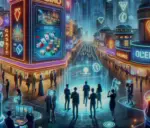Analyzing the history of fan-made mods and their prevailing influence on the video game industry.
While some of the most popular franchises in video game history are considered to be the product of wealthy publishers and large teams of developers, many of them began as humble modifications, or “mods” created by individual or small teams of “modders.”
Mods are a type of software created by “modders”; software developers, specifically those with coding and design experience, for specific games. These mods are usually free and the result of gamers trying to improve a game in a way that the developers might not care to, or be capable of, or because the modders want to create new ways of playing it. Some mods go on to foster their own communities within the grander fanbase. Once a mod reaches a certain level of popularity, its creators often receive funding from a publisher to turn the mod into a full-fledged game. This game may go on to achieve great popularity, sometimes greater than the original game.
Modders develop and integrate programs or software into video games to alter various aspects such as mechanics, optimization, visuals, content and more. The mechanics of a game refer to how the player controls and interacts with and inside the video game. Optimization allows a video game to run better, making it more CPU efficient or maybe even getting the game to run on a system it was not designed for. The CPU is a computer’s brain and is responsible for completing technical tasks and through optimization these tasks can be completed faster. Visuals refer to the game’s aesthetics, music, character design, graphical realism etc… video. Modders can, and have, added extra content to video games, sometimes by adding more levels,characters, weapons, or skins/outfits. One famous example is the CreepyPasta mod for “Minecraft”, which fills the normally serene with famous internet legends such as Slenderman, Smiledog, Jeff the Killer and more. This practice is particularly widespread in the PC market due to the system’s extensive usage and compatibility with game design softwares such as Unity, CryEngine, RPG Maker and more.
Some of the earliest video game mods originated from “Doom” (1993), thanks to several factors; one being how the game’s rampant popularity gave modders a large audience to serve and work with, selling 2-3 million copies by 1999. Additionally, the release of its source code in 1997 and Id Software’s encouragement of the modding community motivated gamers to edit the game in whichever way they desired. The game’s source code is basically the blueprint for the whole game, and gives modders the ability to edit it as they see fit. “The Master Levels for Doom II”, an expansion released in 1995, further fueled modding with new levels created by contracted programmers.
The expansion also included “Maximum Doom”, which featured over 3,000 user-made levels, incorporated content from diverse media sources, showcasing the creativity and collaborative spirit within the modding community.
One of the most popular “Doom” mods is the “Aliens” Total Conversion mod, which makes every aspect of the game look and feel as if it’s set in the “Alien” franchise. Currently, “Doom” is considered one of the most well made and bestselling franchises in the industry, with the latest installment, “Doom Eternal”, earning $450 million within the first nine months of release.
The humble beginnings of the MOBA (multiplayer online battle arena) genre can be traced back to the “Aeon of Strife” fan mod for “StarCraft: Brood War” in 1998. This mod was created by a user, Gunner_4_ever, in 1998 and was also optimized for “Warcraft 3: Reign of Chaos” in 2002.
This mod would then get replaced by “DotA Allstars”, a mod developed by Steve “Guinsoo” Feak, who later joined Riot Games. After Guinsoo left the mod, an anonymous developer IceFrog, joined VALVe in 2009 to develop “Dota 2”, which was released in 2013.
Such developments heavily influenced the genre, leading to the creation of iconic titles such as “League of Legends”, which Guinsoo worked on, “Heroes of the Storm” by Blizzard in 2015 and “Vainglory” by SuperEvilMegacorp in 2014. MOBAs are considered some of the most popular and lucrative games in the industry.
By 2024 “DOTA 2” and “League of Legends” earned a combined total of $2.8 billion. These industry giants would not exist today if not for the works of a handful of creators who wanted to create some free content for a game they enjoyed almost twenty years ago.
Another mod which displays the technical skill of modern modders is”MotherVR”, for the video game “Alien: Isolation”. This mod was made single-handedly by Zack “Nibre” Fannon and revived the game’s virtual reality capabilities. Though the game was originally released compatible with virtual reality headsets, once the game became outdated, the developers stopped supporting it; causing the game to become incompatible with modern VR headsets. During an interview with Digital Trends, he said, “Many problems that existed with the original implementation, like disorienting view calibration, complicated setup, uncomfortable positioning restrictions, are now for the most part taken care of. And some new features, like SteamVR, IPD adjustment, snap-turning, in-game VR settings, and VR controller support have been added.” The mod succeeded in popularizing the game, at least for a short while, as can be seen by the plethora of videos created by gamers trying out the game in VR’, especially by large creators such as Jacksepticeye.
The history and prevalence of mods in the video game industry show that although much of the ecosystem is controlled by giant companies, much of it is due to the efforts of individual creators. The modding community didn’t just create mods because of profit, but because they wanted to elevate the experience of everyone who played. Modding is still prevalent, if not growing, in the industry and is sure to affect it in ways that will resonate for a long time.

















